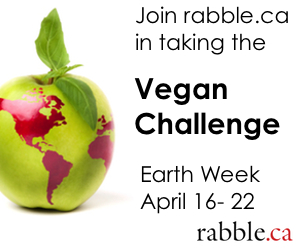If you are anything like me, you’re probably feeling completely unprepared. I was a vegetarian for three years before I decided to give veganism a shot. Even then, I felt totally intimidated. Vegetarians mostly just look at one thing (meat) and avoid it. Vegans have so much more to think about — meat, eggs, butter, milk, gelatine, not to mention animal processing and by-products that aren’t even labeled on the food you’re buying.
It sounds overwhelming. It sounds impossible. But so does ending gender-based violence or eliminating institutional racism. Veganism is just another activist project. We can tackle the Vegan Challenge the same way we do global injustice, by starting with small daily actions.
Here’s how to get started.
1. Understand why you’re doing this.
Everyone goes vegan for different reasons. My partner and I first chose to be vegan for environmental reasons. Animals require food, space and transportation. Each pound of meat uses many times more resources than the same weight in vegetables. Figuring out why you want to take the Vegan Challenge makes the whole week meaningful. It’s motivation. It always helps you stay in a positive space. You aren’t on a “vegan diet” to lose weight. It’s not about depriving yourself or missing bacon for a week. Having a greater purpose allows you to stay on track throughout the week because you want to.
2. Stock your fridge and pantry.
It’s actually easy to be vegan once you learn how to cook without animal products. The simplest way to avoid accidentally eating non-vegan food is to just have as much control over your food as possible. The more processed a product, the more likely something weird is in there. Buy a ton of whole vegetables for the week, lots of rice, pasta, quinoa and tofu. Cans of beans or tomatoes are essential for easy meals. Bulk stores have a new place in my heart. It’s the easiest way to get stuff like textured vegetable protein. TVP are tiny dehydrated granules of delicious that kind of look like ground beef. You can add TVP to pasta sauces, chillies or even salads. You can also pick up some nutritional yeast while you’re there. It’s a flakey cheese substitute that you can sprinkle on popcorn or use to make a kicking faux cheese sauce.
3. Find support.
Take the Vegan Challenge with a friend, use this chance to hit up your local vegetarian association or reach out to vegan acquaintances. Even just subscribing to the vegan sub-reddit or chatting on babble can be a huge help. This is also a great way to raise awareness about animal rights, sustainable food and eco-friendly eating.
4. Allow yourself to adjust.
Just because you’re vegan doesn’t mean you’re a health nut. When I first started feeling crazy urges to eat stacks of cheese or meat, I turned to junk food. Some Doritos are vegan, as are most meat-flavoured chips. I’m not a big believer in processed meat-substitutes, but if you can afford it and are in a crunch, get the fake bacon at the supermarket. There are lots of fake-meat type products and veggie burgers — just make sure eggs aren’t used as a binding ingredient.
We all accidentally eat something non-vegan once in a while — this week, you’ll make mistakes as you go. No activist is perfect. But if we all work together we can create change.



